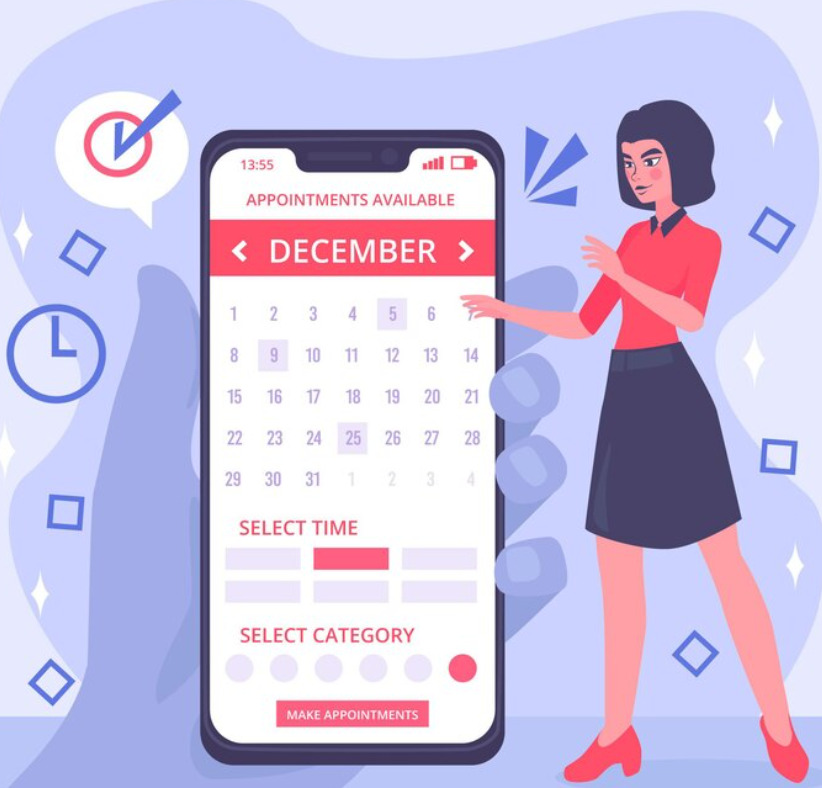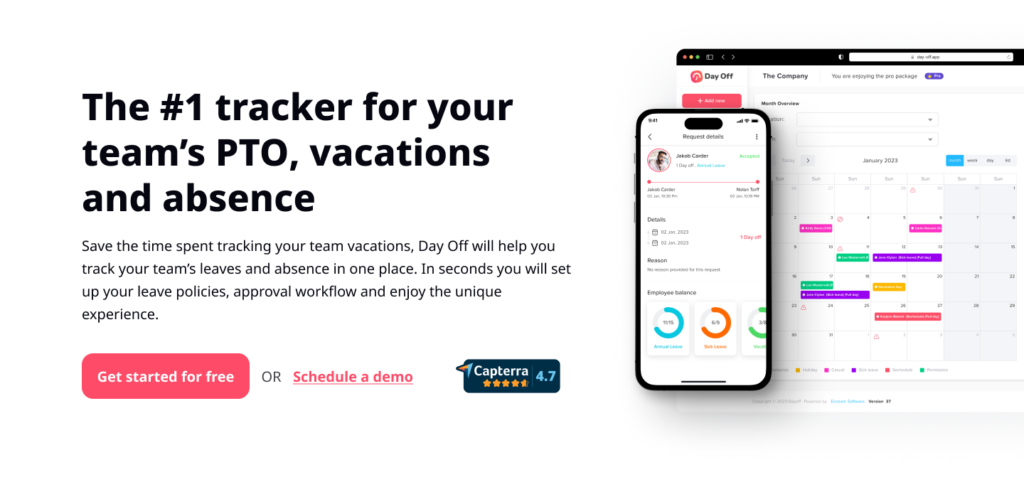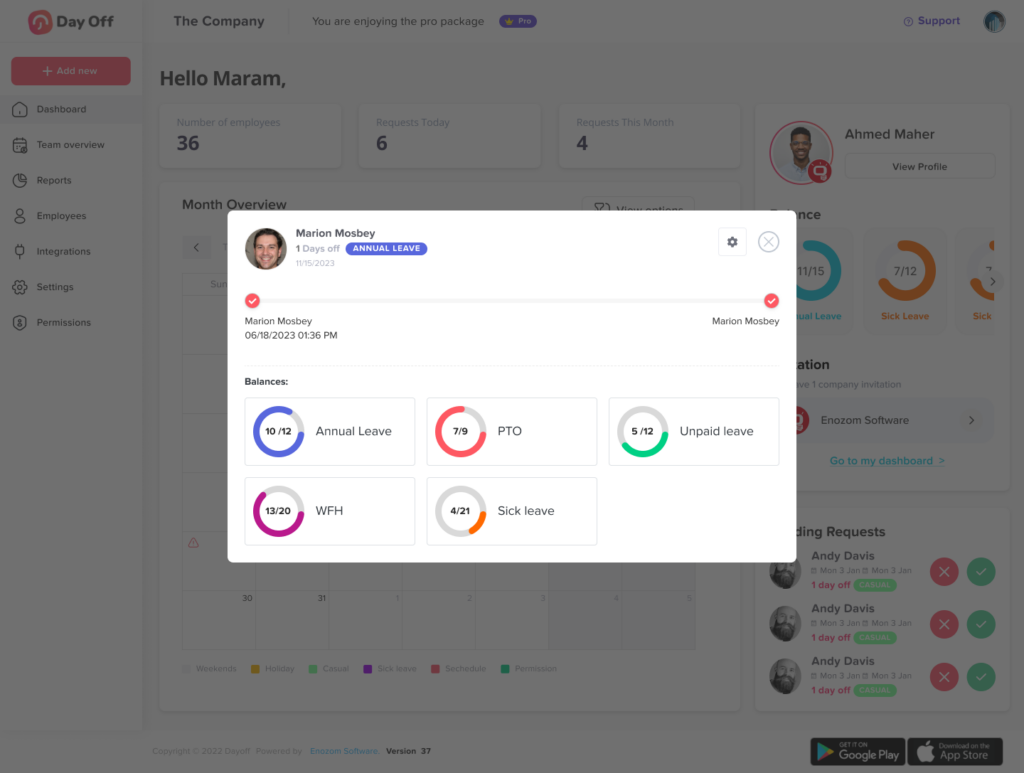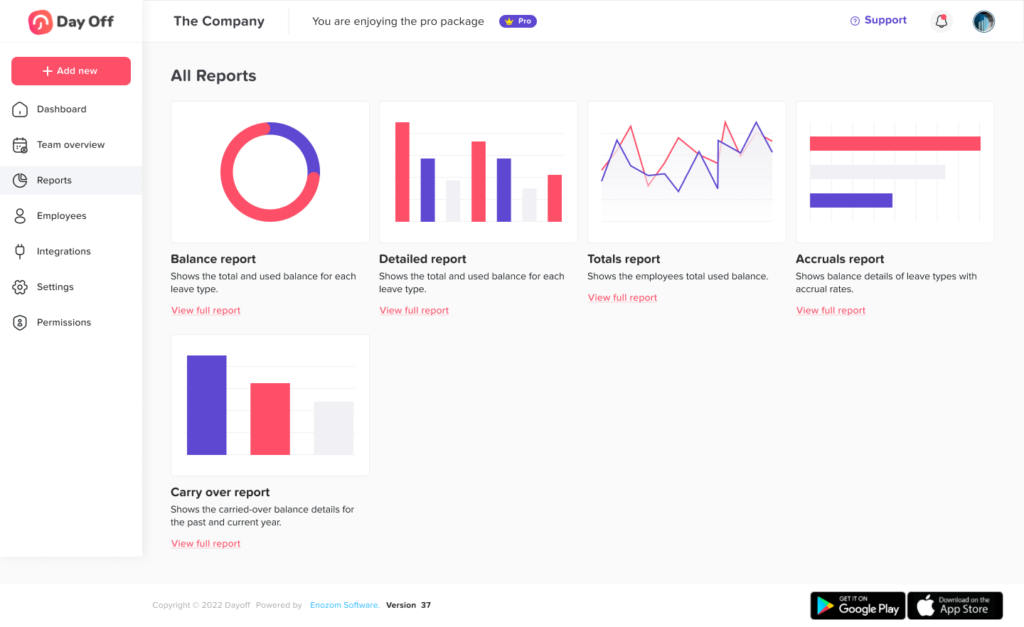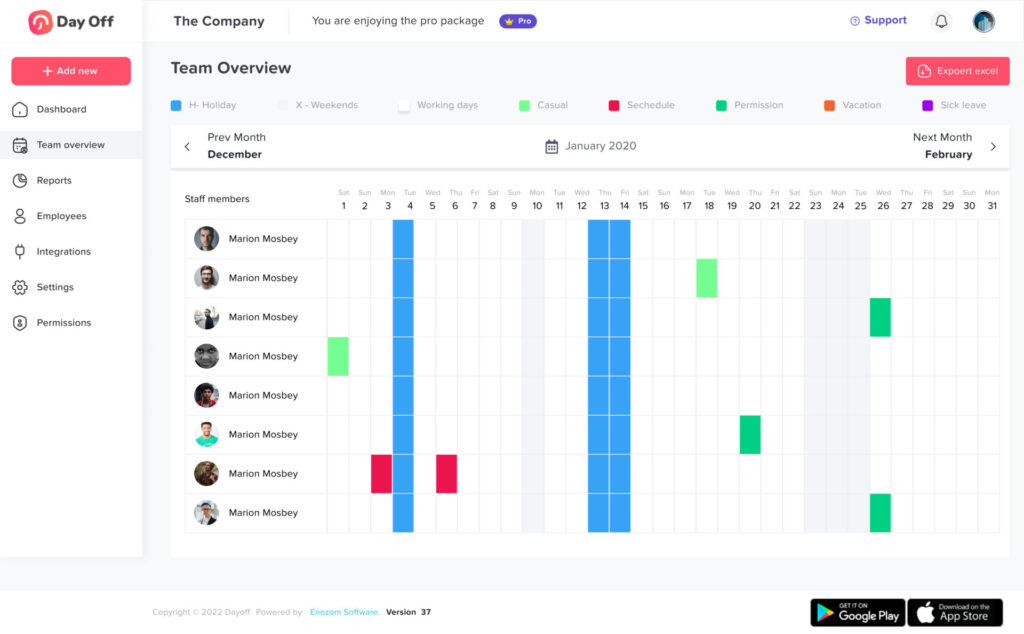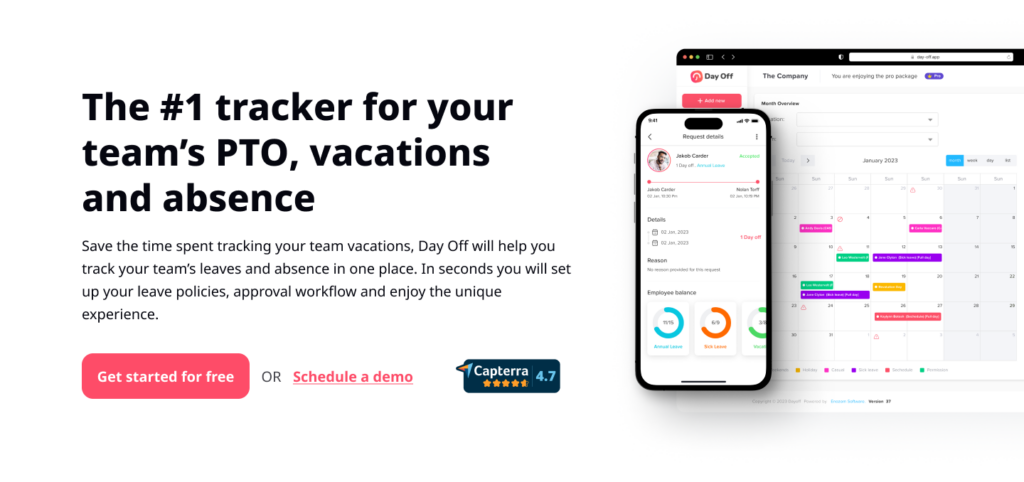Requesting vacation time should be a simple and positive experience, after all, taking time off is essential for maintaining your well-being and productivity. However, for many employees, the process can feel a bit intimidating, especially if you’re new to the company, unsure about the policy, or requesting time off during a busy period.
This comprehensive guide will walk you through every step of the process, from understanding your company’s vacation policy to following up on your request. By following these best practices, you’ll increase the chances of getting your time off approved smoothly and professionally.
Pro Tip: Tools like Day Off App, the #1 tracker for your team’s PTO, vacations, and absences, make the process easier than ever. With Day Off, you can manage leave requests, approval workflows, and calendar integrations (Google, Outlook, Slack) seamlessly in one place.
Understand Your Company’s Vacation Policy
Before you request time off, make sure you know exactly how your company handles vacation days. Most misunderstandings occur when employees are unaware of the formal procedures or eligibility criteria.
Key things to check:
-
Accrual Rates: Understand how vacation time accumulates. Some companies offer a fixed number of days per year, while others accrue time gradually each pay period.
-
Eligibility Requirements: New employees may need to complete a probation period before taking paid time off.
-
Notice Period: Check how far in advance you need to submit your request. Many companies require at least two weeks’ notice, but it can vary.
-
Blackout Dates: Some companies block vacation requests during busy seasons (e.g., retail during holidays or finance during end-of-quarter).
-
Carry-Over Rules: Learn whether unused vacation days can be rolled over to the next year or if they expire.
-
Approval Workflow: Identify the exact process for requesting time off, who approves it, how to submit it, and how confirmation is given.
Tip: Using a PTO management tool like Day Off App can help you track accrued days, request approvals, and view team availability instantly.
Plan Your Vacation Dates Wisely
Timing is everything. A well-timed vacation can help you recharge without creating challenges for your team or disrupting important projects.
Considerations when planning your dates:
-
Workload Cycles: Avoid scheduling time off during major deadlines, audits, launches, or busy seasons.
-
Team Calendar: Review your team’s schedule to avoid overlapping absences.
-
Personal Timing: Align your vacation with personal events (family trips, holidays, celebrations) while staying flexible if needed.
-
Length of Vacation: For long vacations (more than a week), plan further in advance and offer additional support for coverage.
-
Buffer Days: Consider including buffer days before or after major projects to ensure a smooth transition.
Pro Tip: If you plan vacations early, you not only secure your preferred dates but also give your manager enough time to prepare for your absence.
Communicate with Your Team First
Before submitting your official request, have a quick chat with your colleagues or project team. This step shows teamwork, respect, and foresight.
Why it matters:
-
You avoid scheduling conflicts with others’ vacations.
-
You give your team the opportunity to plan workload distribution.
-
You build trust and demonstrate that you’re considerate of shared responsibilities.
Even a short message like:
“Hey everyone, I’m thinking of taking some time off from [start date] to [end date]. Does that conflict with any deadlines or vacations you have planned?”
can go a long way in fostering collaboration.
Submit Your Request According to Company Procedure
Once you’ve done your research and planning, it’s time to make your request official.
Follow your company’s preferred method:
-
Email: Write a professional and polite email with all the relevant details (dates, coverage plan, and contact info).
-
HR Portal or App: Use tools like Day Off App to submit and track requests.
-
Verbal Requests (if allowed): Always follow up with written confirmation to ensure there’s a record.
Your request should include:
-
Dates you plan to be away.
-
Any partial workdays or flexible options (if applicable).
-
How your work will be managed in your absence.
-
Your contact information for emergencies.
Offer a Clear Plan for Your Absence
Managers appreciate employees who think ahead. Before leaving, make sure you have a strategy for how your responsibilities will be handled.
Good coverage plans include:
-
Delegation: Identify who will cover specific tasks or meetings while you’re away.
-
Preparation: Complete any high-priority tasks before your vacation begins.
-
Documentation: Provide detailed handover notes with key contacts, project statuses, and instructions.
-
Communication: Inform clients or stakeholders of your upcoming absence and provide an alternate contact.
Example:
“I’ve completed all reports due next week and briefed [Colleague Name] on ongoing projects. They’ll handle urgent queries while I’m away.”
This proactive approach reassures your manager and team that work will continue seamlessly.
Be Flexible and Open to Negotiation
Sometimes, the dates you request may not be ideal for your team. Be open-minded if your manager suggests alternative days.
How to handle it:
-
Listen to their concerns calmly.
-
Explain your reasoning politely.
-
Suggest possible compromises (e.g., shorter duration, adjusted dates).
Showing flexibility demonstrates professionalism and helps maintain a positive relationship with your manager.
Follow Up Professionally
If you haven’t received a response within a reasonable timeframe (e.g., one week), it’s fine to send a polite follow-up.
Example:
“Hi [Manager Name], I just wanted to follow up on my vacation request submitted on [date]. I’d like to finalize my travel plans soon and wanted to check if you need any additional information.”
Keep your tone courteous and understanding, your manager likely has competing priorities.
Prepare Before You Leave
Once your request is approved, ensure a smooth handover.
Checklist before your vacation:
-
Set up an out-of-office message on email and Slack.
-
Organize your workspace and files.
-
Share your handover document with your team.
-
Notify relevant clients, vendors, or partners.
-
Ensure your backup has access to all necessary tools.
Bonus Tip: Spend your last day before vacation wrapping up loose ends and ensuring no one is left waiting on you.
Enjoy Your Vacation, and Truly Disconnect
When your vacation starts, commit to resting. You’ve earned it!
-
Avoid checking work emails unless absolutely necessary.
-
Let your team handle things, that’s why you planned ahead.
-
Use your time to relax, travel, or focus on personal goals.
You’ll return more energized, creative, and ready to tackle new challenges.
Using Technology to Simplify Vacation Requests
Modern workplaces are increasingly using automation and HR tech to manage time-off requests efficiently.
Benefits of tools like Day Off App:
-
Streamlined approval workflow.
-
Real-time visibility into team schedules.
-
Calendar integrations with Outlook, Google Calendar, and Slack.
-
Customizable leave policies and reporting.
-
Employee transparency and reduced admin workload.
By leveraging these tools, both managers and employees save time, reduce errors, and improve communication.
Frequently Asked Questions (FAQ)
How far in advance should I request my vacation?
The best practice is to request your vacation as early as possible, ideally a few weeks in advance. Most workplaces appreciate at least two to four weeks’ notice for short vacations, and even longer if you’re planning to be away for more than a week or during a busy season.
Early notice gives your manager and team enough time to prepare for your absence, adjust project timelines, and ensure adequate coverage. The earlier you plan, the smoother the approval process will be.
What should I include when I make a vacation request?
A clear, complete vacation request makes approval easier. Include:
-
The exact dates you’ll be away.
-
Whether you’ll be available at all (or completely offline).
-
A brief outline of how your work will be covered, for example, tasks you’ll complete beforehand and who will handle urgent issues in your absence.
-
Any relevant project updates or deadlines that fall during your vacation.
Showing that you’ve thought about the impact on your team builds confidence and shows responsibility.
Can my manager deny my vacation request?
Yes, managers can deny vacation requests if your absence would negatively affect operations or overlap with another teammate’s approved leave.
However, a denial doesn’t have to be the end of the conversation. Politely ask if alternative dates might work better, or if a shorter or split vacation could be approved. Flexibility often leads to a win-win solution.
What happens if multiple coworkers request the same vacation days?
When several people want the same time off, especially around holidays, companies usually apply a first-come, first-served or seniority-based policy.
To avoid disappointment, submit your request early and check with your team before doing so. Some workplaces rotate holiday coverage to keep things fair. Open communication helps prevent tension and ensures everyone gets their fair share of time off throughout the year.
How can I increase the chances of my vacation being approved?
Plan early, communicate clearly, and show professionalism. Before submitting your request:
-
Make sure your chosen dates don’t conflict with key projects or deadlines.
-
Talk to your teammates to coordinate schedules.
-
Prepare a coverage plan.
-
Use the company’s official process for requesting time off (like your HR app or portal).
Managers are far more likely to approve time off when they can see you’ve prepared responsibly and that your absence won’t disrupt the team.
What if my vacation request is denied?
If your request is denied, don’t take it personally. Ask for feedback, maybe it’s a timing issue or a critical deadline period. Then, suggest alternative dates or even partial time off.
For example, instead of a full week, you could propose a few long weekends or shift your dates slightly. The goal is to find a compromise that balances your needs with the company’s workload.
Can I take unpaid vacation if I don’t have enough paid time off?
In many workplaces, yes, with your manager’s approval. Unpaid vacation is often considered for special circumstances such as family events, travel opportunities, or emergencies when you’ve already used your PTO balance.
Always discuss it in advance and put the agreement in writing to avoid confusion about pay and time records.
How do I handle vacation requests during busy or critical seasons?
If your company has a “busy season,” plan strategically. Try to avoid peak times, but if you absolutely must take time off, provide a strong justification and a thorough coverage plan.
For example, you might offer to complete extra work before leaving or assist with a handover that ensures no disruption occurs. Managers appreciate employees who are honest about their needs but also considerate of team priorities.
Should I talk to my coworkers before requesting vacation time?
Absolutely, and it’s one of the most overlooked steps. Discussing your plans with teammates before submitting a formal request helps prevent conflicts and shows professionalism.
A quick conversation such as, “I’m planning to take a few days off in mid-August, does anyone else have vacations booked around then?” can make coordination much smoother and avoid scheduling overlaps.
What’s the best way to follow up on a pending vacation request?
If you haven’t received an answer after a reasonable time (typically a week), it’s perfectly appropriate to follow up. Keep your tone polite and professional.
You could say:
“Hi [Manager’s Name], I just wanted to check on my vacation request for [dates]. I’m hoping to finalize travel plans soon. Please let me know if you need any additional information.”
This shows initiative and courtesy, both appreciated traits in the workplace.
What if I need to cancel or change my vacation after it’s approved?
Plans change, and most companies understand that. Notify your manager as soon as possible if you need to adjust your dates. Early notice allows them to update schedules and communicate changes to the team.
If travel or personal emergencies force you to change plans last minute, explain the situation clearly and work collaboratively to find a solution.
What should I do to prepare for my vacation before I leave?
Preparation is key to enjoying your vacation stress-free. Before leaving:
-
Finish any critical tasks or projects.
-
Create a clear handover document for your colleagues.
-
Set an out-of-office message on your email and chat apps.
-
Inform clients or external partners who may need to contact someone else while you’re away.
Being proactive minimizes disruption and makes it easier for everyone while you’re gone, including you when you return.
What’s a good out-of-office email message to use?
Here’s a simple, professional template:
“Thank you for your message. I am out of the office from [start date] to [end date] and will have limited or no access to email. For urgent matters, please contact [Colleague’s Name] at [email/phone]. I will respond to your message when I return on [date].”
Keep it brief, polite, and informative. If you work with external clients, make sure someone is available to handle their needs during your absence.
What if I need to take time off unexpectedly due to an emergency?
Emergencies happen, whether it’s illness, a family matter, or something unforeseen. In these cases, notify your manager or HR as soon as possible. Explain the situation briefly, without oversharing personal details, and estimate how long you might be away.
If company policy allows, your absence may fall under sick leave, family leave, or unpaid emergency leave. Transparency and prompt communication are key.
How can I make sure my work is covered while I’m away?
Start by identifying the tasks that will need attention while you’re gone. Then:
-
Assign temporary owners for each task.
-
Share a clear handover document with progress updates, next steps, and contact info.
-
Let your team know where to find files and information.
-
Set realistic expectations for what can wait until your return.
This level of preparation makes your absence seamless and demonstrates reliability.
Should I stay in touch with work while I’m on vacation?
Ideally, no. Time off is meant for rest, not remote work. Set clear boundaries before you leave so your team knows whether you’ll be available.
If you’re in a role that requires occasional check-ins, schedule specific times and keep them brief. But whenever possible, disconnect completely, you’ll come back more refreshed and productive.
What happens to my unused vacation days at the end of the year?
It depends on your company’s policy. Some organizations allow you to roll over a limited number of unused days into the next year, while others follow a use-it-or-lose-it policy where unused time expires.
Some employers also offer a vacation payout option, converting unused time into cash. Always check your company’s specific policy to avoid losing any benefits.
Can I request vacation during my probation period?
It depends on your company’s rules. Many businesses prefer that new hires complete their probationary period (usually 3–6 months) before taking paid vacation.
However, if you have an important event planned before you were hired, mention it during onboarding — some managers will approve unpaid or pre-arranged leave as a courtesy.
How can I request vacation time professionally without sounding hesitant?
Be clear, confident, and courteous. Avoid overly apologetic language; instead, focus on preparation and responsibility.
For example:
“Hi [Manager], I’d like to request vacation time from [date] to [date]. I’ve already confirmed coverage with [Colleague] and ensured all major tasks will be completed before I leave. Please let me know if this works.”
This tone shows that you value both your time off and your team’s workflow.
What should I do when I return from vacation?
When you get back, take time to catch up thoughtfully rather than rushing. Review emails, check project updates, and talk to your teammates about anything that changed while you were away.
Thank the colleagues who covered for you, small gestures like this build goodwill. You can even share a short “return summary” email to update everyone on your status and upcoming plans.
What if I work remotely or in a different time zone, does the process change?
Not really, but communication becomes even more important. Make sure your digital calendar is up to date, clarify your local holidays, and ensure your handover includes time-zone-friendly coverage details.
Remote teams often rely on tools like Day Off App or shared calendars to keep visibility high, so everyone knows when teammates are away regardless of location.
Is it okay to take several short vacations instead of one long one?
Definitely. In fact, research shows that taking shorter breaks more frequently can help maintain energy and prevent burnout throughout the year.
Just make sure your short breaks don’t interfere with team operations or project milestones. Discuss your approach with your manager so your plans align with team goals.
Should I tell my manager where I’m going on vacation?
You’re not obligated to share personal details about your travel plans. It’s perfectly fine to keep it simple, all your manager needs are your vacation dates and your coverage plan.
If sharing helps with coordination (for example, time zone differences), that’s fine, but it’s entirely optional.
How can I track my vacation balance easily?
Instead of manually calculating your remaining days, use a time-off management tool like Day Off App. It automatically tracks your accrued days, approvals, and balances, while syncing with calendars like Google, Outlook, and Slack.
Having visibility into your balance helps you plan vacations responsibly and prevents surprises at the end of the year.
Why is taking vacation time so important?
Vacation time isn’t just a perk, it’s essential for your health and productivity. Taking regular breaks reduces stress, prevents burnout, and boosts creativity.
Employees who use their PTO come back more focused, engaged, and motivated. Remember, rest is not a luxury, it’s part of sustainable professional success.


